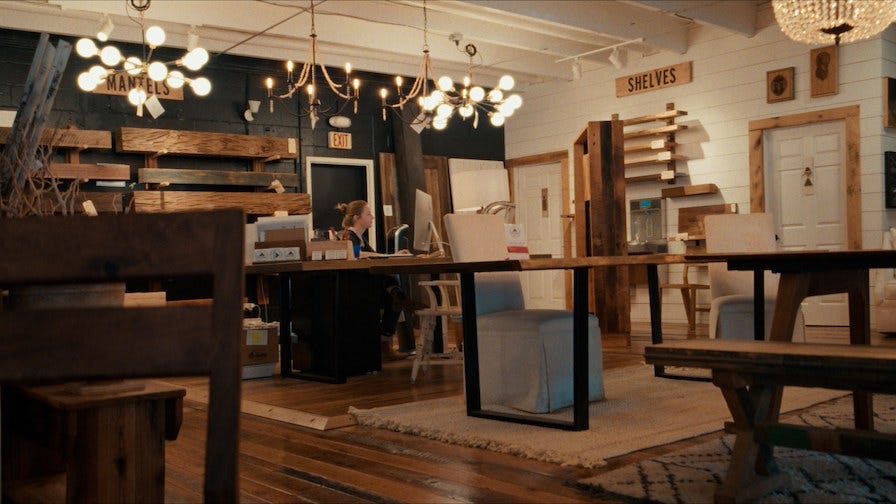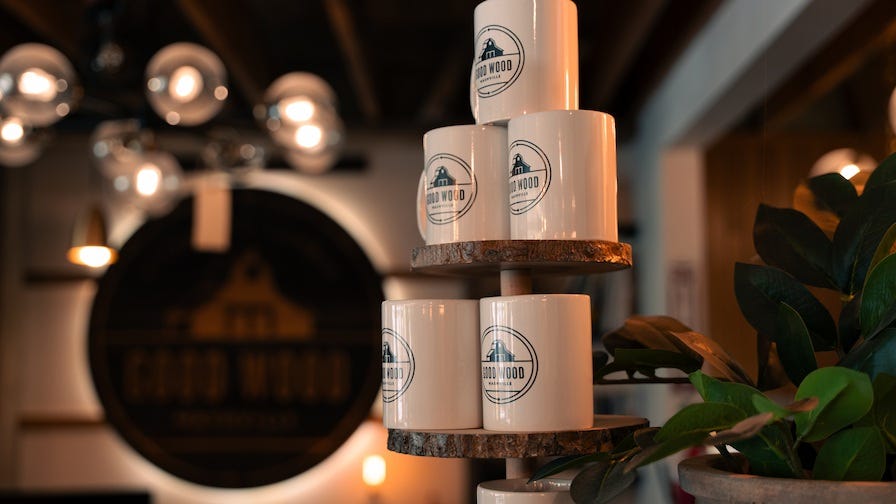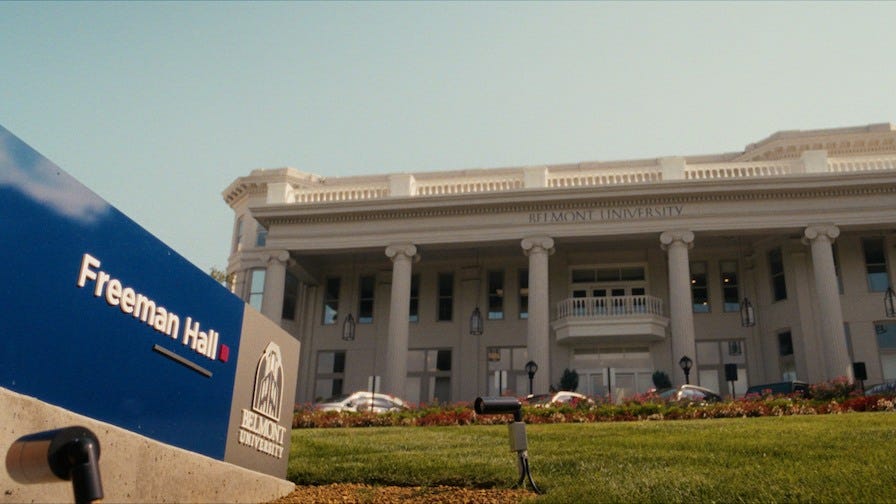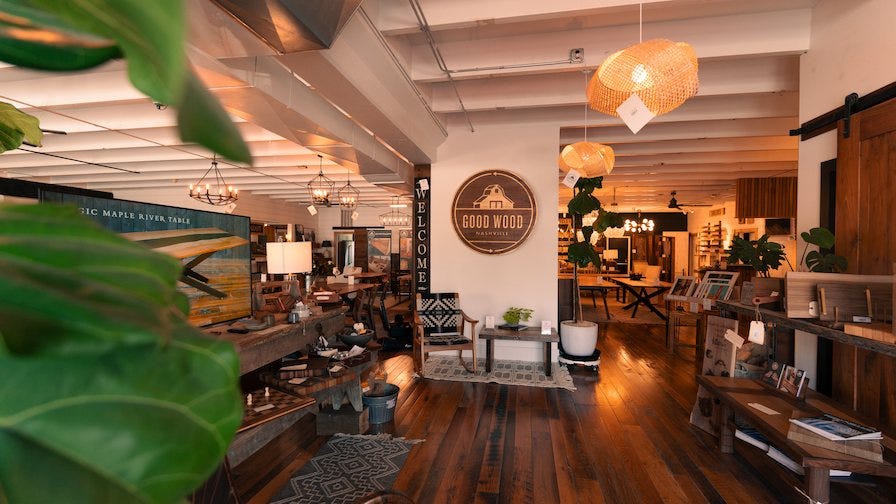By Olivia Eaker, Wood-Mizer
January 25, 2024
Good Wood Nashville, located in scenic Nashville, Tennessee, is dedicated to turning salvaged and reclaimed wood from tragedies, natural disasters, and urban development into amazing works of art including a once-in-a-lifetime project with Belmont University.
Finding the Good in Wood


The very idea that good things can come from saving wood is what inspired Dave Puncochar to create Good Wood Nashville. “I bought a 1906 Victorian in East Nashville, a lot of historic homes. And I walked into that house and half of the floors were damaged,” says Dave. “The interesting thing was the floors were old-growth poplar, it is very hard to find old-growth poplar. So, you know it was kind of a quest for me to figure out how to match those floors. My frustration in my process of trying to solve my own problem is actually what stimulated me to start Good Wood Nashville.”


In addition, Dave and his family have witnessed firsthand the destruction and damage that natural disasters can have on a community when the tornadoes of 2020 hit Nashville. “I was trying to put my life back together…so we saved as many of our own trees as we could as well. Just to preserve and try to make something good out of that tragedy,” says Dave.


Through their mission, Good Wood Nashville is doing amazing sustainable work by creating projects with wood that would typically be discarded. According to the World Resources Institute, "Each year, 36 million trees come down in cities across the United States due to disease, development, or old age. Much of this wood ends up burned, chipped into mulch, or tossed into landfills." Good Wood Nashville is helping recover and upcycle that would-be urban wood waste into higher-value products such as furniture, flooring, and construction material.
Traditioned Innovation


Since 2012, Good Wood Nashville has dedicated its craftsmanship to the individuals and community of Nashville. Most notably, their once in a lifetime project with Belmont University.
The porch on the oldest academic building on campus, Freeman Hall, had begun to exhibit noticeable signs of wear and tear. After examining the columns and making holes at the top to remove them from inside the decorative column cladding, it was clear that four of the six timber columns which held up the porch had rotted and needed replaced.


Upon removal of the rotted columns, Belmont University Architect in Residence, David Minnigan, explains that he noticed several of them being taken to the dumpster. “I saw them and said, ‘Don’t throw those away.’ I didn’t know exactly what was going to happen, but I knew that if we didn’t save those columns, we would never have the opportunity to do something. I called my good friend Dave Puncochar at Good Wood and said we've got this great opportunity to do something, I don’t know if they're any good or not, I don’t know what kind of wood it is. But I know you and I know you know wood and I know you know how to reuse old things and make things new,” says David.


Upon removal of the rotted columns, Belmont University Architect in Residence, David Minnigan, explains he noticed several of them being taken to the dumpster. "I saw them and said, 'Don't throw those away.' I didn't know exactly what was going to happen, but I knew that if we didn't save some columns, we would never have the opportunity to do something. I called my good friend Dave Puncochar at Good Wood and said we've got this great opportunity to do something. I don't know if they're any good or not, I don't know what kind of wood it is. But I know you and I know wood and I know you know how to reuse old things and make things new," says David.


According to Belmont University, “The prolific American Chestnut in its prime totaled more than four billion trees at the beginning of the 20th century. As a dominant species in the eastern United States, it became one of the largest, tallest and fastest growing trees in the region. The wood is also known as ‘wormy chestnut,’ referring to trees that succumbed to the chestnut blight of the early 1900s which killed off nearly the entire population. Worms tore through the trees leaving holes and discoloration. Many trees were too far gone, but those still usable were harvested for use as affordable lumber.”
To increase the usage of the historic 20th century American chestnut columns, Good Wood decided to mill the wood very thin, almost like a veneer. After 8 months, Dave and his team were able to create a stunning conference table that seats 15 to 18 people and now sits in the heart of the Belmont University campus in the Jack C. Massey Center.


“The main purpose of this building is to showcase the collaborative spirit of education. It is the welcome center of the university. Every potential student that comes to Belmont University will pass through the doors and see this building,” explains David. “Belmont has a saying that we are about traditioned innovation and I think that this table is the embodiment of traditioned innovation. Because of the talents that have been utilized, we have something that will live forever.”


With a special opening ceremony, Good Wood Nashville’s work not only received appreciation from Belmont University students, faculty, and alumni but the entire local community. “When people know what we did for Belmont, word gets out,” says Dave.
From Root to Table
Good Wood Nashville likes to work in two specific ways with craftsmen as well as individuals. “Good Wood does work with a lot of designers, architects, and luxury builders. So, we do work with the trade. And then we also do work direct to consumer with homeowners and families who call us and want us to build something for them,” says Dave.


What kind of wood they use then depends on the customer and their wants and needs. “Sometimes they have their own wood, sometimes they don’t. Sometimes we can tell them the story of wood we have in stock which is really special,” shares Dave.


Good Wood Nashville loves to take wood that would normally be thrown away and turn it into something unique and meaningful that will last generations. “If you had a 100-year-old tree in your parent’s yard that fell down we have the capability to come on out to your yard and milling it right there or grabbing the log, milling it, and making something out of it, anything,” explains Good Wood Nashville's Director of Operations, Ken Hood.


Good Wood makes the most out of each piece with the use of their Wood-Mizer LT50WIDE portable sawmill which allows them to turn logs and beams into boards, slabs and more. “That’s what I love about the sawmill, you just get to see the beauty that’s in there. All we are doing is revealing the beauty that’s there. And then one day a year or two later we'll turn it into furniture and say look at the grain again. It’s a really magical time,” says Dave.


The entire team is truly excited and passionate about the work they are doing for their community. “From the root to the table, I feel like our whole team as they touch it are highly skilled, very capable, and really great people,” says Dave.
Family & Community


Dave gives much of the success of Good Wood to his talented team. “Early on I knew I needed help, cause I love talking to people, but you can’t do both. You can’t run the business and build the furniture. Or be with customers and be moving stacks of wood all at the same time. So, over the course of 11 years now, we have had steady growth as a team. I feel like we've got the best team we've ever had,” says Dave.


“Every day at Good Wood is different and it's one of the things I love about it. We have four full time furniture makers, we have two guys that are kind of our flex guys. They might to installs they might help with furniture, and then we have a sales team, a support team, an admin team, and office managers. And then me who's always just having hands in a little bit of everything, looking for new vendors, looking for trees, I love running the sawmill,” says Dave.


“The people are absolutely amazing and that’s the first thing I picked up on day one when I started working here. It really just seems like a big family,” says Ken.


This family-feel also extends to the community of Nashville as well. “It's just so special to be a part of the community where we can be a part of things that make the community more beautiful and mean things to people, I love that,” says Dave.
Being such a close-knit team has allowed Good Wood to better help their community by providing quality crafted, unique wood products from would be waste. “You know we don’t sell plastic widgets that are made in another country, what we do is we make things that people make memories around. The things we make…they have a lot of soul and I think that’s because the people that work here have a lot of soul and they put everything they’ve have into every piece…I’m just proud to be a part of that process,” says Dave.


Dave’s future goal for Good Wood is to continue to see them grow. “We’ve got some of the best artisans in the country, we’ve got some of the best woodshops and sawmills in the country, and we’re just having fun. We’re just getting started,” says Dave.


To connect with more urban wood programs and learn how you can make a difference, visit the Urban Wood Network.


